Getting Started
About This Guide
This document is applicable for Secure Workload release 3.8:
-
Introduces the key Secure Workload concepts: Segmentation, Workload labels, Scopes, Hierarchical scope trees, and Policy discovery.
-
Explains the process of creating the first branch of your scope tree using the first-time user experience wizard.
-
Describes the automated process of generating policies for the chosen application based on actual traffic flows.
Introduction
Traditionally, network security is aimed at keeping malicious activities out of network with firewalls around the edge of your network. However, you also need to protect your organization from threats that have breached your network or originated within it. Segmentation (or microsegmentation) of the network helps to protect your workloads through controlling traffic between workloads and other hosts on your network; therefore, allowing only traffic that your organization would require for business purposes, and deny all other traffic.
For example, you can use policies to prevent all communication between the workloads that host your public-facing web application from communicating with the research and development database in your data center, or to prevent non-production workloads from contacting the production workloads.
Cisco Secure Workload uses the organization’s flow data to suggest policies that you can evaluate and approve before enforcing them. Alternatively, you can also manually create these policies for segmenting your network.
Tour of the Wizard
Welcome to Secure Workload. Labeling and grouping your workloads is essential to the power of Secure Workload.
Onboarding is a user-friendly and guided approach to help you set up and deploy applications securely in your environment. You can segment your network to allow only the traffic that is required for your business, and block all other communications.
To help you get started, choose Overview on the left menu to navigate to the Quick Start Wizard. The wizard typically prepares Secure Workload to start creating segmentation policies to control traffic on your network, presents a series of steps, each focusing on a specific security aspect, and prompts users to make informed choices for configuring their workload securely.
The following user roles can access the wizard:
-
site administrator
-
customer support
-
scope owner
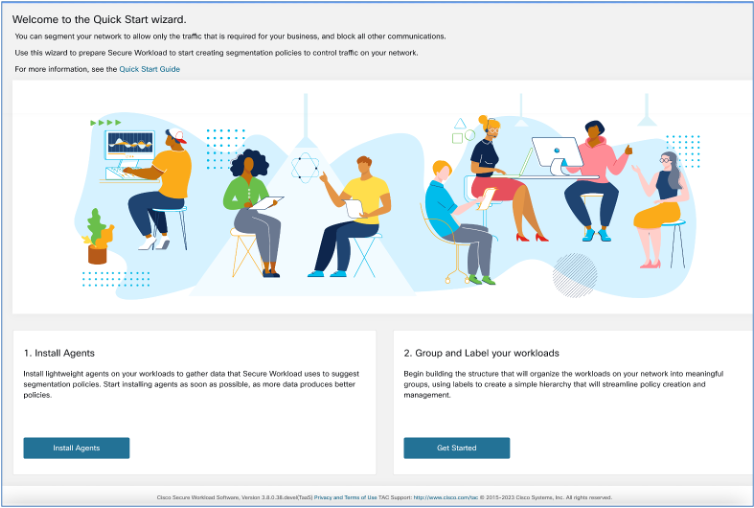
Install Agents
In Secure Workload, you can install software agents on your application workloads. The software agents collect information about the network interfaces and the active processes running on the host system.
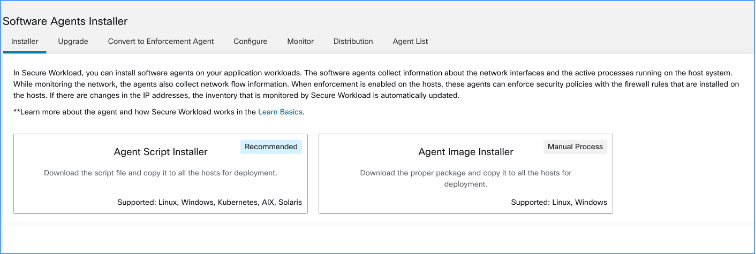
There are two ways how you can install the software agents:
-
Agent Script installer-Use this method for installing, tracking, and troubleshooting of issues while installing the software agents. Supported platforms are Linux, Windows, Kubernetes, AIX, and Solaris
-
Agent Image installer-Download the software agent image to install a specific version and type of software agent for your platform. Supported platforms are Linux and Windows.
The onboarding wizard walks you through the process of installing the agents based on the selected installer method, see the installation instructions on the UI and the user guide for additional details on installing software agents.
Group and Label your Workloads
Assign labels to a group of workloads to create a scope. The hierarchical scope tree helps to divide the workloads into smaller groups. The lowest branch in the scope tree is reserved for individual applications.
Select a parent scope from the scope tree to create a new scope, which contains a subset of the members from the parent scope.
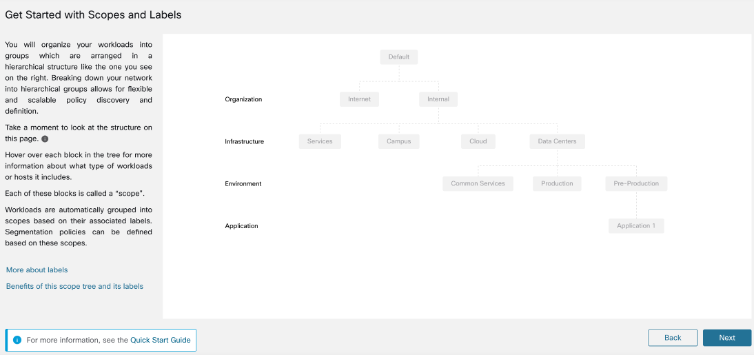
On this window, you can organize your workloads into groups, which are arranged in a hierarchical structure. Breaking down your network into hierarchical groups allows for flexible and scalable policy discovery and definition.
Labels are key parameters that describe a workload or endpoint, it is represented as a key-value pair. The wizard helps to apply the labels to your workloads, and then groups these labels into groups called scopes. Workloads are automatically grouped into scopes based on their associated labels. You can define segmentation policies based on the scopes.
Hover-over each block or scope in the tree for more information about the type of workloads or hosts it includes.
 Note |
In the Get Started with Scopes and Labels window, Organization, Infrastructure, Environment and Application are the keys and the text in the gray boxes in-line with each key are the values. For example, all workloads belonging to Application 1 are defined by these set of labels:
|
The Power of Labels and Scope Trees
Labels drive the power of Secure Workload, and the scope tree created from your labels is more than just a summary of your network:
-
Labels let you instantly understand your policies:
"Deny all traffic from Pre-Production to Production"Compare this to the same policy without labels:
"Deny all traffic from 172.16.0.0/12 to 192.168.0.0/16" -
Policies based on labels automatically apply (or stop applying) when labeled workloads are added to (or removed from) inventory. Over time, these dynamic groupings based on labels greatly reduce the amount of effort required to maintain your deployment.
-
Workloads are grouped into scopes based on their labels. These groupings let you easily apply policy to related workloads. For example, you can easily apply policy to all applications in the Pre-Production scope.
-
Policies created once in a single scope can automatically be applied to all workloads in descendant scopes in the tree, minimizing the number of policies you need to manage.
You can easily define and apply policy broadly (for example, to all workloads in your organization) or narrowly (to just the workloads that are part of a specific application) or to any level in between (for example, to all workloads in your data center.
-
You can assign responsibility for each scope to different administrators, delegating policy management to the people who are most familiar with each part of your network.
Build the Hierarchy for Your Organization
Start to build your hierarchy or scope tree, this involves identifying and categorizing the assets, determining the scope, defining roles and responsibilities, developing policies and procedures to create a branch of the scope tree.
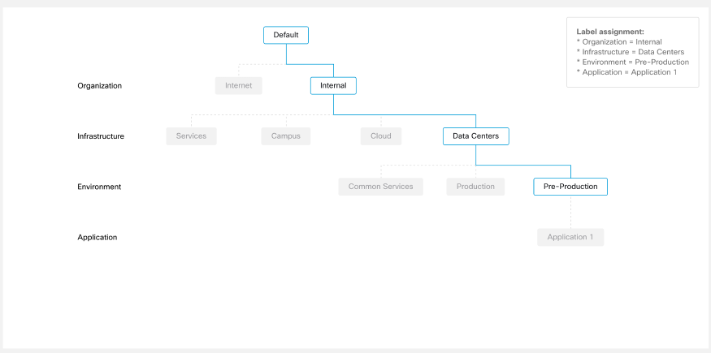
The wizard guides you through creating a branch of the scope tree. Enter IP addresses or subnets for each blue-outlined scope, the labels are automatically applied based on the scope tree.
Pre-requisites:
-
Gather IP Addresses/Subnets associated with your Pre-Production environment, your data centers, and your Internal network.
-
Gather as many IP addresses/subnets as you can, you can the additional IP addresses/subnets later.
-
Later, as you build your tree, you can add IP addresses/subnets for the other scopes in the tree (the gray blocks).
To create the scope tree, perform these steps:
Define the Internal Scope
The internal scope includes all IP addresses that define your organization's internal network, including public and private IP addresses.
The wizard walks you through adding IP addresses to each scope in the tree branch. As you add addresses, the wizard assigns labels to each address that defines the scope.
Organization=InternalBy default, the wizard adds the IP addresses in the private internet address space as defined in RFC 1918
 Note |
All the IP addresses need not be entered at once, but you must include the IP addresses associated with your chosen application, you can add the rest of the IP addresses at a later time. |
Define the Data Center Scope
This scope includes the IP addresses that define your on-premises data centers. Enter the IP addresses/subnets that define your internal network
 Note |
Scope names should be short and meaningful. |
On this window, enter the IP addresses that you have entered for the organization, these addresses must be a subset of the addresses for your internal network. If you have multiple data centers, include all of them in this scope so you can define a single set of policies.
 Note |
You can always add more addresses at a later stage. For instance, the wizard assigns these labels to each of the IP addresses: |
Define the Pre-Production Scope
This scope includes IP addresses of non-production applications and hosts, such as development, lab, test, or staging systems.
 Note |
Ensure you do not include addresses of any applications that are used to conduct actual business, use them for the production scope that you define later. |
The IP addresses you enter on this window must be a subset of the addresses you entered for your data centers, include the addresses of your chosen application. Ideally, they should also include pre-production addresses that are not part of the chosen application.
 Note |
You can always add more addresses at a later stage. |
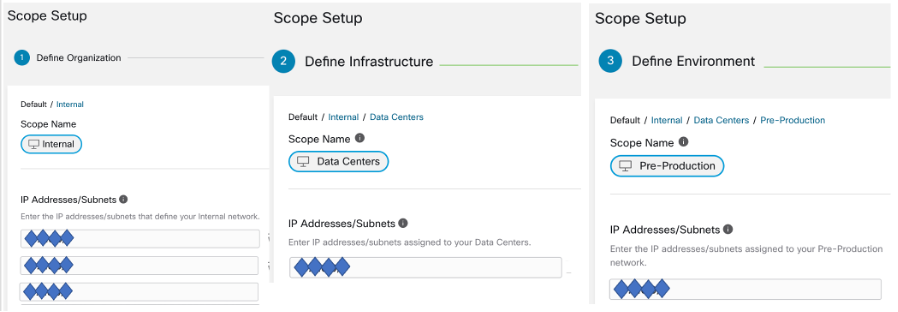
Review Scope Tree, Scopes, and Labels
Before you start creating the scope tree, review the hierarchy that you can see on the left window. The root scope shows labels that were automatically created for all configured IP addresses and subnets. At a later stage in the process, applications are added to this scope tree.
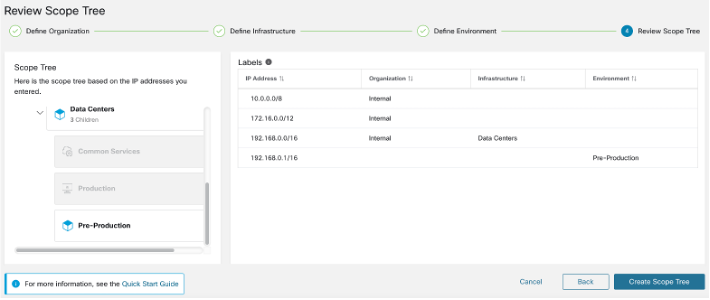
You can expand and collapse branches and scroll down to choose a specific scope. Onthe right pane, you can see the IP addresses and labels assigned to the workloads for the specific scope. On this window, you can review, modify the scope tree before you add an application to this scope.
 Note |
If you want to view this information after you exit the wizard, choose Organize > Scopes and Inventory from the main menu, |
Review Scope Tree
Before you start creating the scope tree, review the hierarchy that you can see on the left window. The root scope shows labels that were automatically created for all configured IP addresses and subnets. At a later stage in the process, applications are added to this scope tree.

You can expand and collapse branches and scroll down to choose a specific scope. On the right pane, you can see the IP addresses and labels assigned to the workloads for the specific scope. In this window, you can review and modify the scope tree before you add an application to the scope.
 Note |
If you want to view this information after you exit the wizard, choose Organize > Scopes and Inventory from the main menu. |
Create Scope Tree
After you review the scope tree, create the scope tree.
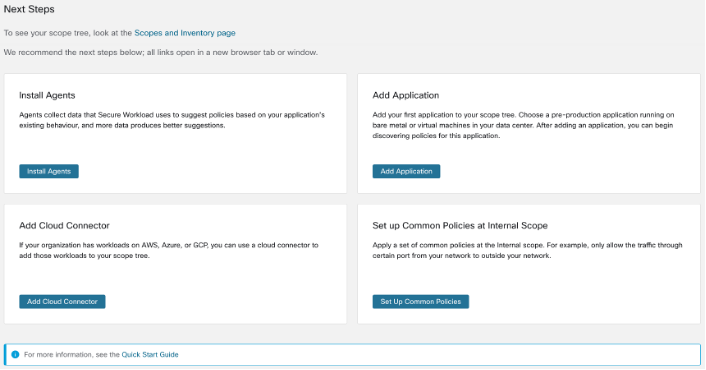
For information on the scope tree, see the Scopes and Inventory sections in the user guide.
Next Steps
Install Agents
Install the SecureWorkload agents on the workloads associated with your chosen application.The data that the agents gather is used to generate suggested policies based on the existing traffic on your network. More the data, more accurate policies are produced. For details, see the Software Agents section in the Secure Workload user guide.
Add Application
Add the first application to your scope tree. Choose a pre-production application running on bare metal or virtual machines in your data center. After adding an application, you can begin discovering policies for this application. For more information, see the Scopes and Inventory section of the Secure Workload user guide.
Set up Common Policies at Internal Scope
Apply a set of common policies at the Internal scope. For example, only allow the traffic through certain port from your network to outside your network.
Users can define policies manually using Clusters, Inventory Filters and Scopes or these can be discovered and generated from flow data using an Automatic Policy Discovery.
After you have installed agents and allowed at least a few hours for traffic flow data to accumulate, you can enable Secure Workload to generate ("discover") policies based on that traffic. For details, see Automatically Discover policies section of the Secure Workload user guide.
Apply these policies at Internal (or Inside or Root) scope to effectively review policies.
Add Cloud Connector
If your organization has workloads on AWS, Azure, or GCP, use a cloud connector to add those workloads to your scope tree. For more information, see the Cloud Connectors section of the Secure Workload user guide.
Quick Start Workflow
|
Step |
Do This |
Details |
|---|---|---|
|
1 |
(Optional) Take an annotated tour of the wizard |
|
|
2 |
Choose an application to start your segmentation journey. |
For best results, follow the guidelines in Choose an Application for this Wizard. |
|
3 |
Gather IP addresses. |
The wizard will request 4 groups of IP addresses. For details, see Gather IP Addresses. |
|
4 |
Run the wizard |
To view requirements and access the wizard, see Run the Wizard. |
|
5 |
Allow time for the agents to gather flow data. |
More data produces more accurate policies. The minimum amount of time required depends on how actively your application is used. |
|
6 |
Generate ("discover") policies based on your actual flow data. |
Gather IP Addresses
You will need at least some of the IP addresses in each bullet below:
-
Addresses that define your internal network
By default, the wizard uses the standard addresses reserved for private internet use.
-
Addresses that are reserved for your data centers.
This does not include addresses used by employee computers, cloud or partner services, centralized IT services, etc.
-
Addresses that define your non-production network
-
Addresses of the workloads that comprise your chosen non-production application
For now, you do not need to have all of the addresses for each of the above bullets; you can always add more addresses later.
 Important |
Because each of the 4 bullets represents a subset of the IP addresses of the bullet above it, each IP address in each bullet must also be included among the IP addresses of the bullet above it in the list. |
Choose an Application for this Wizard
For this wizard, choose a single application.
An application typically consists of multiple workloads that provide different services, such as web services or databases, primary and backup servers, etc. Together, these workloads provide the application's functionality to its users.
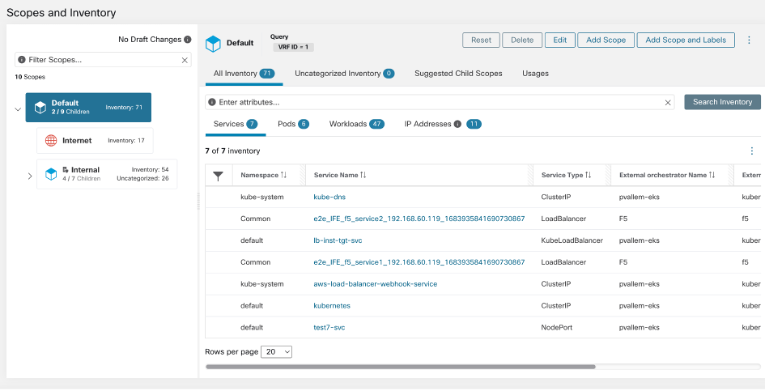
Guidelines for Choosing Your Application
SecureWorkload supports workloads running on a wide range of platforms and operating systems, including cloud-based and containerized workloads. However, for this wizard, choose an application with workloads that are:
-
Running in your data center.
-
Running on bare metal and/or virtual machines.
-
Running on Windows, Linux, or AIX platforms supported with Secure Workload agents, see https://www.cisco.com/go/secure-workload/requirements/agents.
-
Deployed in a pre-production environment.
 Note |
You can run the wizard even if you have not chosen an application and gathered IP addresses, but you cannot complete the wizard without doing these things. |
 Note |
If you don't complete the wizard before signing out (or timing out) or navigate to a different part of the Secure workload application (use the left navigation bar), the wizard configurations are not saved. |
For details about how to add a scope/add Scope and Labels, see the Scopes and Inventory section of the Cisco Secure Workload User Guide.
Run the Wizard
You can run the wizard whether or not you have chosen an application and gathered IP addresses, but you won't be able to complete the wizard without doing these things.
 Important |
If you don't complete the wizard before signing out (or timing out) of Secure Workload, or if you navigate to a different part of the application using the left navigation bar, wizard configurations are not saved. |
Before you begin
The following user roles can access the wizard:
-
site admin
-
customer support
-
scope owner
Procedure
|
Step 1 |
Sign in to Secure Workload. |
|
Step 2 |
Start the wizard: If you do not currently have any scopes defined, the wizard appears automatically when you sign in to Secure Workload. Alternatively:
If you have already created scopes, you cannot access the wizard again unless you delete all existing scopes. To do this, (Optional) Reset the Scope Tree. |
|
Step 3 |
The wizard will explain the things you need to know. Don't miss the following helpful elements:
|
Automatically Generate Policies
Secure Workload generates/discovers policies based on existing traffic between workloads and other hosts. You can modify, supplement, analyze, and eventually approve and enforce policies on the workloads.
Before you begin
-
Install agents on your application's workloads
-
Allow some time after agent installation for flow data to accumulate.
Procedure
|
Step 1 |
On the Next Steps page of the quick start wizard, click Automatically Generate Policies. Alternatively, you can do the following:
|
|
Step 2 |
Choose Manage Policies. |
|
Step 3 |
Choose Automatically Discover Policies. |
|
Step 4 |
Choose the time range for the flow data that you want to include: |
|
Step 5 |
Choose Discover Policies, the generated policies appear on this page. |
(Optional) Reset the Scope Tree
You can delete the scopes, labels, and scope tree you created using the wizard and run the wizard again (optional).
 Tip |
If you only want to remove some of the created scopes and not run the wizard again, delete individual scopes instead of resetting the entire scope tree. To delete a scope, choose Scope and click Delete. |
Before you begin
Scope owner privileges for the root scope are required.
If you have created additional workspaces, policies, or other dependencies, see the Secure Workload user guide for complete information about resetting the scope tree.
Procedure
|
Step 1 |
From the navigation menu on the left, choose Organize > Scopes and Inventory . |
|
Step 2 |
Click the scope at the top of the tree. |
|
Step 3 |
Click Reset. |
|
Step 4 |
Confirm your choice. |
|
Step 5 |
If the Reset button changes to Pending Reset, you may need to refresh the browser page. |
More Information
For more information about concepts in the wizard, see the Secure Workload user guide.
 ) for important information.
) for important information.
 Feedback
Feedback